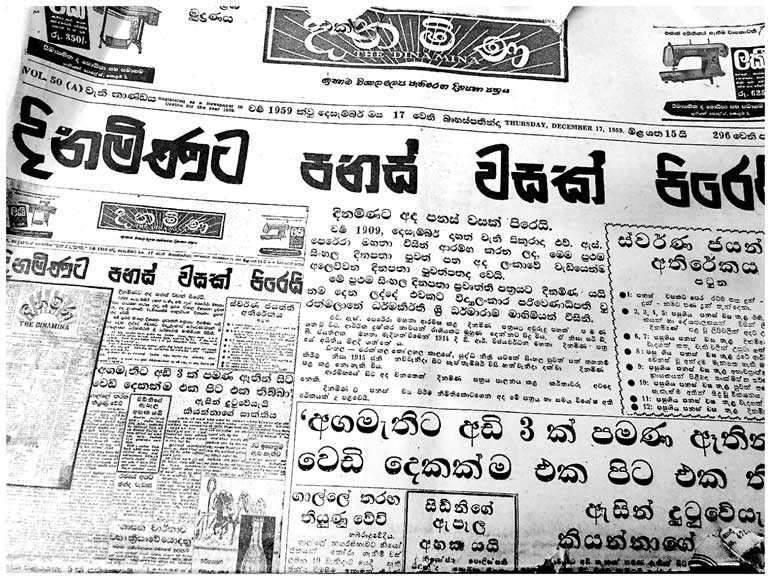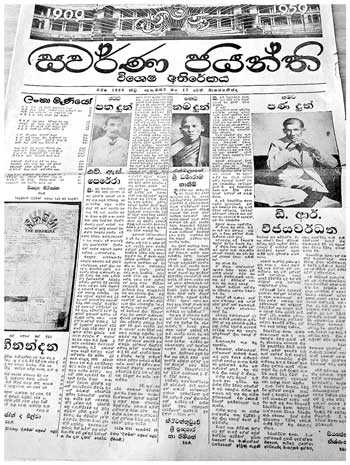Saturday Apr 20, 2024
Saturday Apr 20, 2024
Saturday, 4 May 2019 00:00 - - {{hitsCtrl.values.hits}}

 17 December 1959 was an eventful day for us on the Dinamina. That was the day Dinamina completed 50 years.
17 December 1959 was an eventful day for us on the Dinamina. That was the day Dinamina completed 50 years.
Leading to the day we had a busy time when a special supplement was planned weeks ahead. Although the features desk handled the supplement, some of us on the news desk chipped in to locate material from the issues published during the half century.
The headline on the front page that day read in big bold letters ‘Dinamina completes fifty years’. The lead story briefly carried the progress of the paper over the long period. It was started by H S Perera, who was earlier editor of ‘Sarasavi Sanderesa’ started by the Buddhist Theosophical Society (BTS).
The Dinamina was the first Sinhala daily and the name was given by the erudite monk & head of the Vidyalankara Pirivena Venerable Ratmalane Dharmakirti Sri Dharmarama. Due to financial constrains in 1914 Sir Baron Jayatilaka intervened and arranged for the paper to be bought by D R Wijewardene.
The first 50 years saw eight editors among whom were the renowned novelist Martin Wickremasinghe (1937-1944). Piyasena Nissanka had two spells – once prior to Martin W until he was appointed editor of Silumina and then when Martin W left to devote his full time to write books.
The material for the 12-page supplement which did not carry a single advertisement, was almost entirely picked from what was published during the 50 years. It started with two sets of poems – one by pioneer novelist Piyadasa Sirisena written for the first edition of the Dinamina and the other by John de Silva, best known for his Tower Hall dramas, on 23 December 1909 – six days after the first publication.
Selected articles by celebrated personalities filled four pages, another two pages had quotes from editorials, another featured market prices of goods in 1909, 1934 (25 years later) and  1959, one page on life stories of prominent personalities of the era, two pages on significant happenings during each year , and the history of the paper. How the layout of the paper changed over the years was also featured.
1959, one page on life stories of prominent personalities of the era, two pages on significant happenings during each year , and the history of the paper. How the layout of the paper changed over the years was also featured.
Leading figures of the days – both lay and clergy – had contributed articles on the country’s history and burning issues of the day in the early era. Among the published articles were Sir Baron Jayatilaka on ‘The rise and fall of the Sinhalese kingdom’, E W Perera on his historic trip to London, Ven. Pelene Sri Vajirnana Maha Nayaka Thera on religious debates, Ven Yagirala Pannananda Nayaka Thera on ‘Reform of the Nikayas’, Father S J Perera on the Sinhala kingdom – progress and deterioration, H Sri Nissanka on the national dress, D S Senanayake on agriculture and national pride, S W R D Bandaranaike on future of independent Ceylon and Professor M D Ratnasuriya on ‘A society without gentlemen’. As the titles and the writers indicate the articles were of contemporary interest at the time.
The main article on the leader (editorial) page was by Professor Gunapala Malalasekera (he was then Sri Lanka’s Ambassador in Russia) on how ‘Dinamina strengthened the Nation’. He was a regular contributor to the Dinamina after he moved to Colombo from Peradeniya campus as Chief Editor of the Buddhist Encyclopaedia. An article written by D R Wijewardena on 10 February 1948 on ‘National Newspaper and Independence’ was also reproduced on that page.
The editorial on Dinamina’s 50 years was written by B A Siriwardena – the brilliant writer ‘Sira’, as everyone called him.
The paper carried portrait pictures of national leaders giving recognition to their contribution over the years.
The Dinamina had been sold at 3 cents as it started in 1909, increased by two cents in 1915 (5 cents) and 1948 (7 cents), by three cents in 1950 to 10 cents, again by two cents to 12 cents in 1951. In 1955 the price was 15 cents. Today the paper is sold at Rs. 20.
Collecting material for the supplement was made easy thanks to the excellent Lake House library. The only miss was when we discovered at the last minute on the day the page had to be laid out that one year’s papers were missing.
The only place to check was the Archives Department which was then in Nuwara Eliya. Can we get to Nuwara Eliya before the offices closed? I volunteered to drive up since I knew director Devaraja. It was late when I got there but he opened the doors. I picked a quote and telephoned office from his official phone.